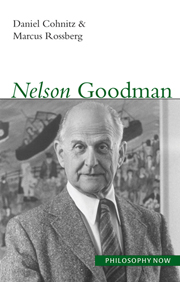Book contents
- Frontmatter
- Contents
- Acknowledgements
- Abbreviations
- 1 The worldmaker's universe
- 2 If this were an emerald it would be grue: problems and riddles of induction
- 3 The big picture
- 4 Particulars and parts
- 5 From Vienna Station to Boston Terminus
- 6 Follow the sign
- 7 Diagnosing art
- 8 Starmaking
- 9 Never mind mind, essence is not essential, and matter does not matter
- List of symbols
- Glossary of technical terms
- Further reading
- Notes
- Bibliography
- Index
6 - Follow the sign
- Frontmatter
- Contents
- Acknowledgements
- Abbreviations
- 1 The worldmaker's universe
- 2 If this were an emerald it would be grue: problems and riddles of induction
- 3 The big picture
- 4 Particulars and parts
- 5 From Vienna Station to Boston Terminus
- 6 Follow the sign
- 7 Diagnosing art
- 8 Starmaking
- 9 Never mind mind, essence is not essential, and matter does not matter
- List of symbols
- Glossary of technical terms
- Further reading
- Notes
- Bibliography
- Index
Summary
Signs and symbols play an important role in our lives. We use them to extract and convey information, to deceive and to reveal. Some symbols are considered natural. Smoke, for example, is said to signal fire. Some symbols are clearly conventional, such as the string of words you are now paying attention to. Some are obviously part of a whole system, such as, for instance, a system of traffic signs. Others seem to stand alone, like calling a friend and letting the phone ring only once to let her know you are on your way without wasting the money for a call. One of philosophers' abiding interests has been how we manage to represent the world with language. But just as there are more ways to do things with words than represent the world, there are also more ways to do that than with words.
Goodman's wider agenda concerning the philosophy of language can, again, be seen as a progressive shift. This time, however, in asking for a theory of language, the question is not asked in the wrong way, but it is rather too narrow. Language, Goodman contends, is merely one of many kinds of symbolic system. Although it is undoubtedly an important one, a full understanding of its working requires a general theory of symbols that encompasses and categorizes all sundry ways of symbolization, including languages, notations, pictures, diagrams and so on. Goodman provides an approach to a theory of symbols in Languages of Art that can in part be seen as a development of his theory of meaning that we introduced in Chapter 3.
- Type
- Chapter
- Information
- Nelson Goodman , pp. 140 - 163Publisher: Acumen PublishingPrint publication year: 2006



